Lake Anna spans multiple counties in Virginia and is a popular fishing spot for both native Virginians and tourists. A rich fishing hole with over 50 years of dedicated angler participation, many different species of fish and other animals can be found in this lake. Are any of the creatures living in Lake Anna dangerous?
1. Largemouth Bass (Micropterus salmoides)

Largemouth bass are ambush predators and often lay in wait for their prey.
©iStock.com/stammphoto
The largemouth bass is one of the more popular fish in Lake Anna and is consistently stocked to ensure abundant supply. Not only is it a fan favorite of fishermen, but it is caught with over 37,000 catches reported in 2010. However, most of these (around 99%) were released. Expect your catches to be around four to six pounds and between 8-15 inches long when catching mature specimens.
These fish can be caught almost any time of the year, but you’ll have the best time catching them around June when they’re feeding voraciously in the middle, open parts of the lake after spawning. Once the full heat of the summer is upon the lake, the Largemouth bass will retreat to cooler areas near grass lines or into deeper water.
Largemouth bass are not dangerous to humans, but they can be ferocious predators of other fish. Stomach content analysis of this species living in Lake Anna revealed they favored some of the other fish in this list like bluegills and white perch.
2. Striped Bass (Morone saxatilis)

Striped bass are a favorite amongst anglers at Lake Anna.
©Ray Hennessy/Shutterstock.com
The striped bass is another species of fish that is stocked yearly in Lake Anna. They are also known amongst anglers as “stripers” or “rockfish. Regularly restocking these fish is a must since they’re one of the more popular species to try to catch. Around 100,000 baby striped bass, or “fingerlings” as they’re called, are released into the Lake Anna per year. Striped bass regularly reaches 22 inches in size at maturity in this lake.
Around April this species can be found in the shallower areas of the “cool side” of the lake, but once the fish spawn they’re more commonly found in the mid-region of the lake for the remaining summer months.
3. Black Crappie (Poxomus nigromaculatus)
By far the most abundantly harvested species is the black crappie. Just under 19,000 of these fish are caught and harvested per year. Black crappies have a cyclical population with a “boom and bust” nature about them. As of 2020 the population present in Lake Anna is about average and the size of each fish is average or above. This makes for great fishing, and an added bonus of black crappies being schooling fish is that once you catch one, you’re likely to catch a few more shortly after!
To find these favorite fish, look in the shallow areas of shores if you’re fishing in early spring. Like other fish species in this lake, they tend to migrate to the more open and deeper waters for the summer where they usually will remain until fall or early winter.
4. Bluegill (Lepomis macrochirus)
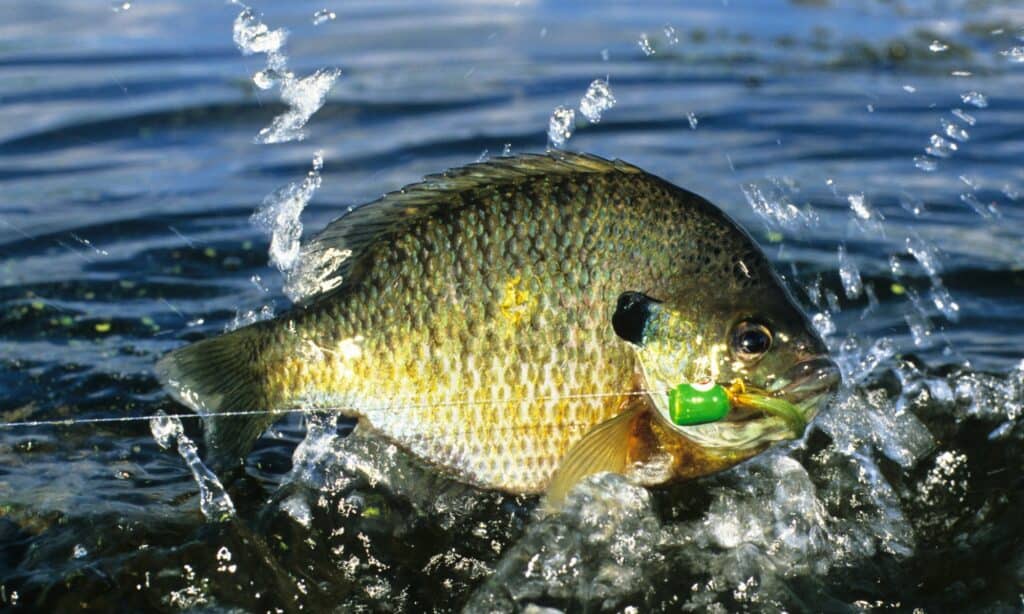
Bluegills get their name from the blue region behind their cheeks.
©iStock.com/stammphoto
While bluegills are present in decent amounts in Lake Anna, their population might not be as plentiful as other species you can find. This would be because of the large amount of diversity in the lake. When a given area has a lot of species diversity, competition can drastically limit populations of less aggressive fish or those who don’t populate as easily.
Still, you can find this fish at a good size with relative ease, especially if you’re using live bait like worms or crickets.
5. Channel Catfish (Ictalurus punctatus)
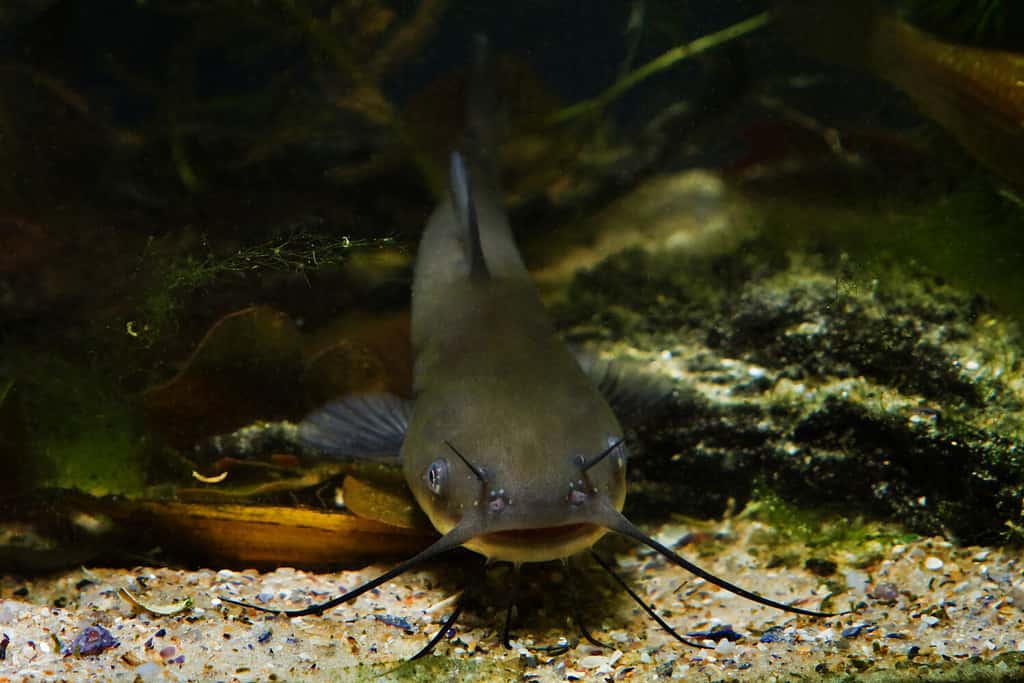
Channel
catfish
are one of the most fished catfish species in the United States.
©Aleron Val/Shutterstock.com
Originally added to the lake in 1972, the channel catfish population has been able to sustain itself since its introduction. A popular summer catch, catfish in Lake Anna can grow to be upwards of 20 inches. In fact, biologists caught a catfish in this lake in 2002 which almost beat the state record for size!
Catfish can seem intimidating with the large barbs on their face. If stung by these barbs, some pain can occur from the mild toxin produced by the fish. While most stings are mild, there is a chance of tissue necrosis. To avoid this, refrain from “noodling” or fishing for them using bare hands. Cut bait such as shrimp over even chicken livers are good to use to fish for these creatures living in Lake Anna.
6. White Perch (Marone americana)
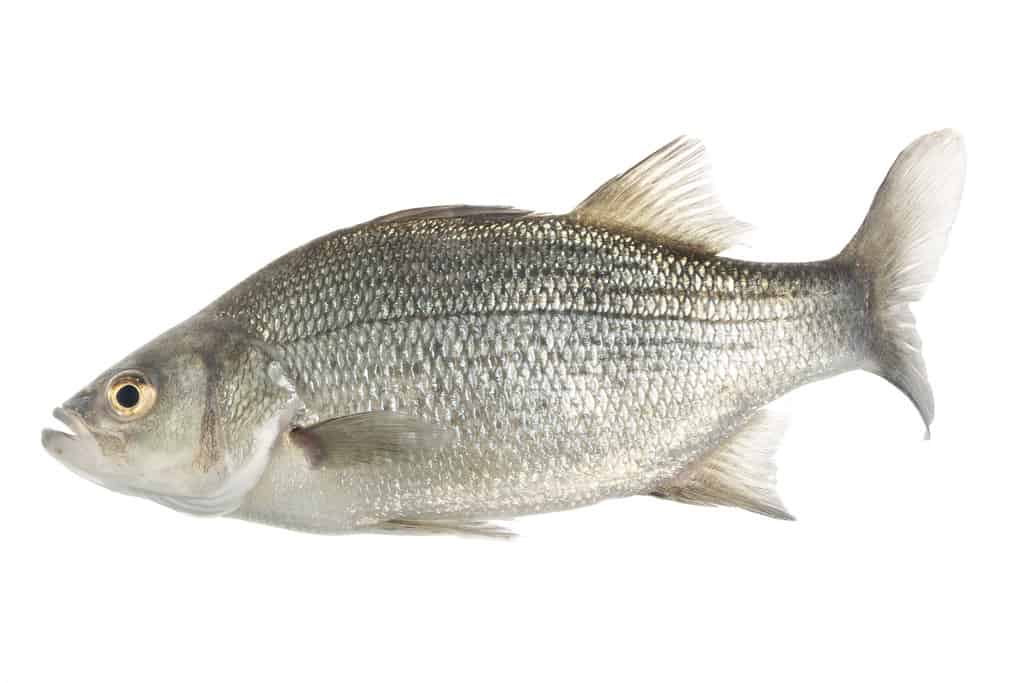
White perch are not true perch. They are members of the Bass family, sometimes called silver bass.
©”White bass” by USFWS Mountain Prairie is marked with Public Domain Mark 1.0. – License
The best time to find white perch in Lake Anna is the fall and winter seasons, though one shouldn’t have an issue finding them at all. This species is the most plentiful fish species in Lake Anna, with the black crappie following closely behind.
As previously mentioned, these fish are prey for some of the other species’ populations. They don’t exactly pose a danger to other fish in the lake, and definitely not to the humans fishing for them!
7. Red-Spotted Newt (Notophthalmus viridiscens)
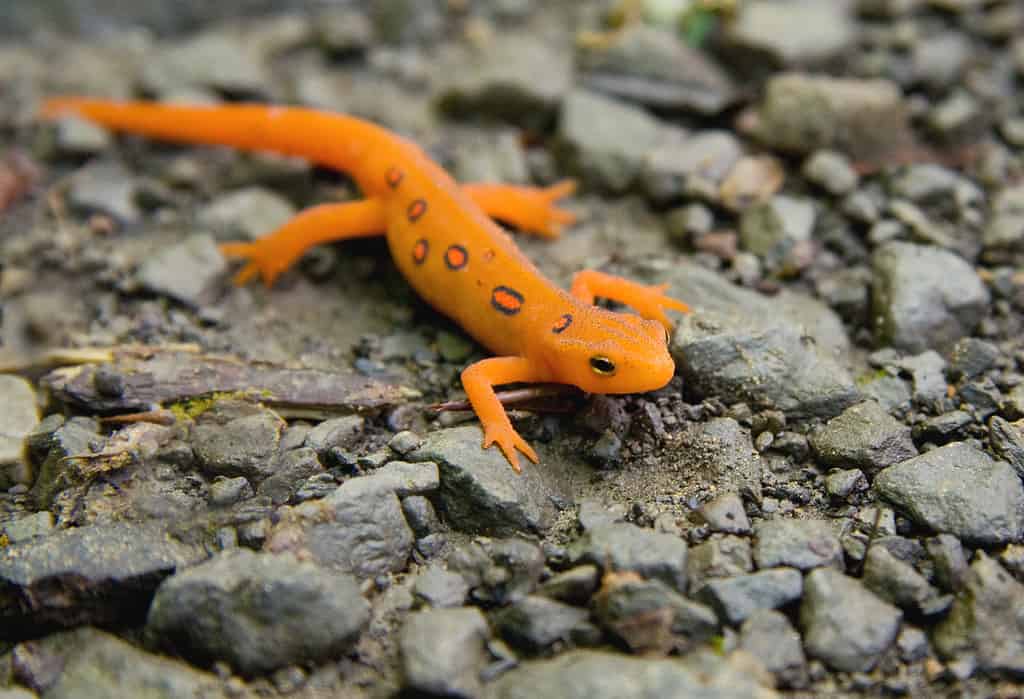
Red-spotted newts are common newts in Eastern North America.
©iStock.com/epantha
The red-spotted newt is also known as the eastern newt thanks to its wide range across the Eastcoast. Newts are a solitary group of amphibians common in water or wet areas of forests. The red-spotted newt is no exception. These newts can be spotted easily due to their bright colors. If you’re looking for them, check alongside water banks and in streams in Lake Anna.
While they don’t pose a threat to humans, they do exude a substance called tetrodotoxin. Some salamanders also produce this toxin. It is one of the most potent toxins known to man. Tetrodotoxin helps the newt avoid predation by being unpalatable to the predator. The bright coloration also indicates to potential predators to stay away. Simply handling these little salamanders won’t poison anyone but be sure to wash your hands thoroughly afterward to avoid accidental ingestion of the toxin.
8. Green Frog (Lithobates clamitans)
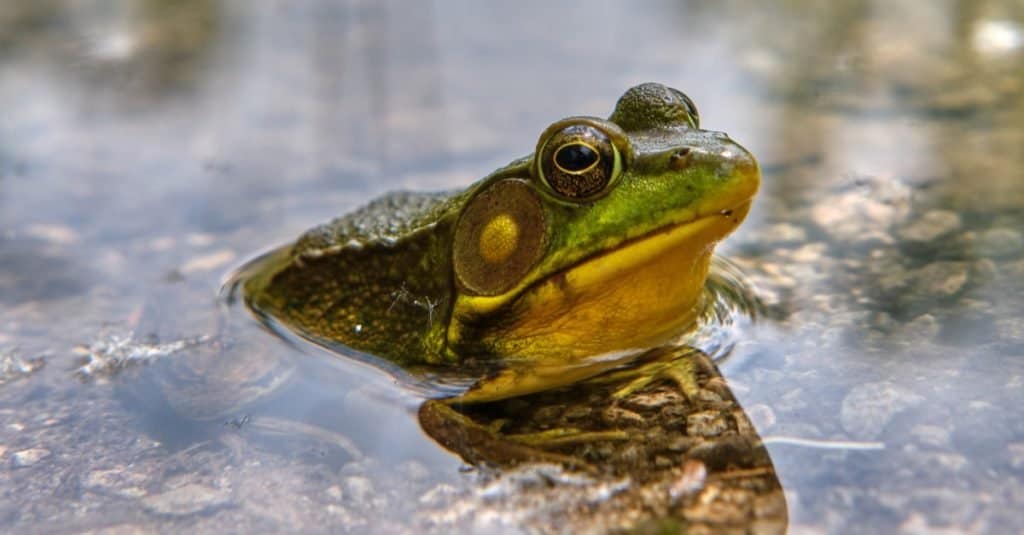
Green frogs dwell in or near bodies of water.
©Cory Shankman/Shutterstock.com
These frogs are a staple in Lake Anna, and they are in abundance near or in water throughout the state park. Tadpoles are also very commonly seen in shallow areas of lakes, ponds, and streams.
They pose no threat to people or even most other animals. Their main food source is insects, but don’t be taken aback if you see them munching on other small frogs or even small snakes. It can also go the other way around: some snakes like copperheads patrol the waterline to catch these frogs as a tasty meal.
9. Southern Two-Lined Salamander (Eurycea cirrigera)
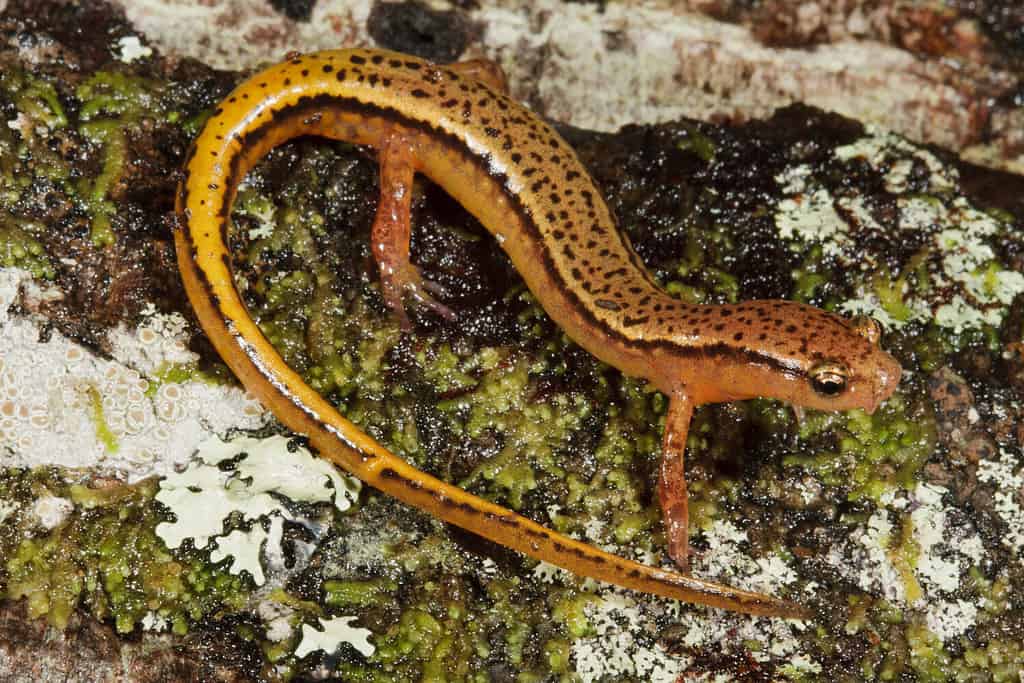
Unsurprisingly, this species gets its name after the two lines that extend down the sides of its slinky body.
©Nathan A Shepard/Shutterstock.com
This adorable salamander is a common creature found living in Lake Anna. They live in streams and nearby water sources and appear to breed exclusively in the water. Interestingly, the female salamander guards her eggs until they hatch. There are at least four other salamander species in Lake Anna State Park, but this species is more common near and in water.
Practice safe handling if you choose to catch and release these creatures. Ultimately, it’s best to just look and enjoy these amphibians from afar.
10. Eastern Cricket Frog (Acris crepitans)
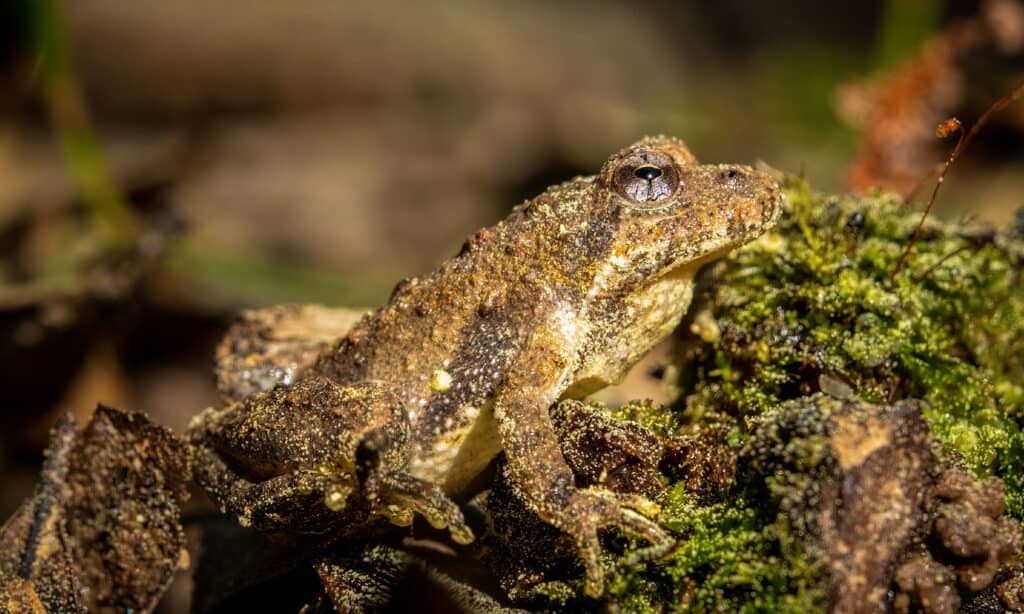
Eastern cricket frogs frequently have a triangle marking on top of their heads.
©samray/Shutterstock.com
In a survey taken in 2018, 55 individuals of the Eastern cricket frog were recorded across 10 sites. These frogs are widespread throughout the lake and other aquatic habitats in the Lake Anna State Park.
Eastern cricket frogs, as suggested by their name, mostly eat crickets. So, people and most creatures larger than cricket-size are in no danger! Eggs of this species are usually on plant leaves or stems, or across the surface in shallow water. You’re most likely to see tadpoles around June.
While handling frogs isn’t inherently dangerous to humans, any handling of amphibians or reptiles can put you in danger of contracting salmonella. Ultimately, it would be more likely you’d cause harm to the frog than the other way around. For the sake of everyone involved, avoid handling the wildlife.
11. Eastern Copperhead (Agkistrodon contortrix)
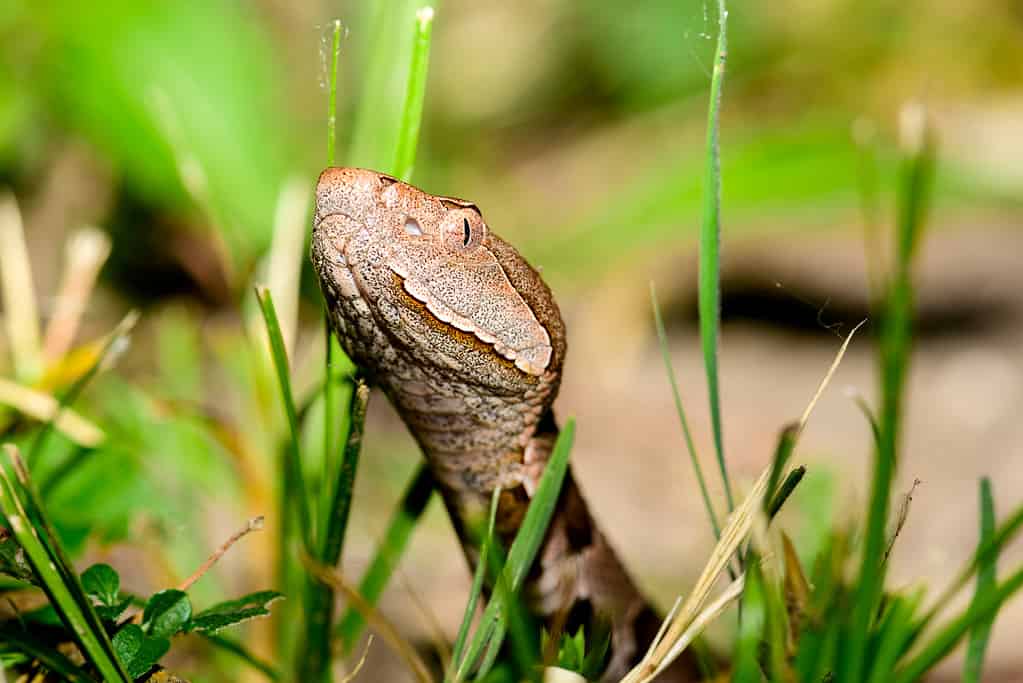
Copperhead snakes are in the viper family Viperidae. They have two hollow fangs which can inject venom.
©iStock.com/JWJarrett
Copperheads are a venomous snake in Lake Anna. These snakes are good at swimming and will glide across the water as easily as they do on the ground. They are actually quite shy snakes and will only attack when provoked or unintentionally (or intentionally) harmed. If you’re swimming in the lake and see one of these large, copper-colored heads swimming towards you, it’s best to get out of the water or at the very least, far away from its path. This will help the creature avoid feeling threatened.
Aside from their brownish-copper coloration, copperheads have hourglass-shaped bands that can easily identify them. They tend to hang around streams and other places their prey like to live, so be extra vigilant when you’re near the water’s edge, especially if you see a lot of activity of their favorite prey like frogs, lizards, or small mammals. If you or a pet are bitten by a copperhead snake, it’s essential to seek immediate medical attention as their venom can cause localized necrosis of the area.
Final Thoughts
Fortunately, there aren’t many dangerous creatures living in Lake Anna. Even a bite from a copperhead is rarely fatal, though you should always seek treatment if you’re on the receiving end of this snake’s fangs. To avoid potential hazards from creatures living in Lake Anna, always respect nature and wildlife and use caution when swimming or hiking. Keep a safe distance from any snakes or other wildlife you see to ensure they don’t feel threatened.
Lake Anna is a diverse, healthy ecosystem in which many different creatures reside. Aside from the plentiful lake, which houses many favorite fish species, there are scores of amphibians, reptiles, and avian species to keep an eye out for if you find yourself in this beautiful location.
The photo featured at the top of this post is © Maclane Parker/Shutterstock.com
Thank you for reading! Have some feedback for us? Contact the AZ Animals editorial team.







